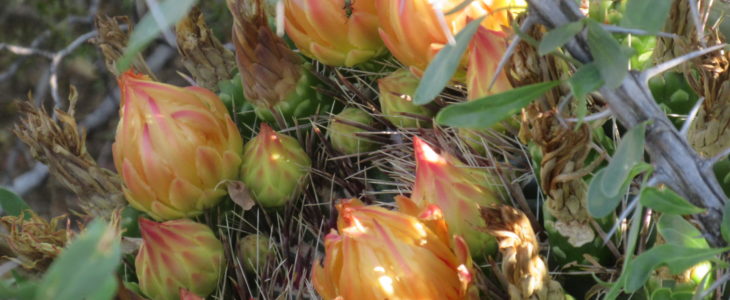
Desert gardening, on a practical level, means gardening in an arid environment. Desert gardening, on a personal level, means gardening in and with the place that I love.

I love watching quail amble through the brittlebushes and goldfinches hop along the wolfberry. I love that the brittlebushes thrive with zero supplemental watering, too.

I love listening to wheat in spring, and corn in the fall. I love that if I skip a day of watering because life is extra crazy, these desert-adapted crops continue.
As I’ve related in Looking Bright, Win Some, Lose Some, Palo Verde Moments, and Lupine Time, I especially love the desert flowers that keep me watching and encouraged by their strength. I do water my pots and some in-ground plants, but honestly not very much. I go with what grows on limited water and divided attention. In my desert garden, the plants get most of the credit, and I love seeing what they can do.
Below is a gallery of desert plants that put on a show this summer in my Tucson garden. They are roughly in order from surviving purely on rainfall, to getting mostly-daily water from me. All are species I recommend for a good chance of success and a reliable supply of smiles.










Blooming is not required –  my drought-deciduous wolfberry gets cheers just for re-growing leaves, and my butterfly mist takes such an afternoon beating it shines by just staying alive (pictured with blooming Indian mallow).
my drought-deciduous wolfberry gets cheers just for re-growing leaves, and my butterfly mist takes such an afternoon beating it shines by just staying alive (pictured with blooming Indian mallow).  A storm beheaded my son’s sunflower plants – and now the bold stems are taking on a branched form to try growing a different way . In the desert, going with what grows might mean accepting different varieties or forms. In my garden, if it doesn’t grow, I simply go with something else. If it tries, I encourage it with both friendly words and water.
A storm beheaded my son’s sunflower plants – and now the bold stems are taking on a branched form to try growing a different way . In the desert, going with what grows might mean accepting different varieties or forms. In my garden, if it doesn’t grow, I simply go with something else. If it tries, I encourage it with both friendly words and water.

What grows for you? What surprises plant themselves, and which plants reward your efforts? The desert supports diverse life. A garden can support both the desert and the gardener.

